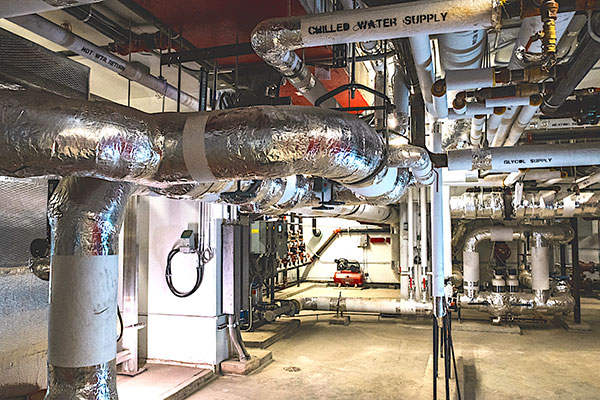
HVAC & Plumbing
Cooling on the Cutting Edge
Turning to water from the bottom of Lake Ontario makes The Taylor a cool new build in Toronto’s downtown.
The post Cooling on the Cutting Edge appeared first on HPAC Magazine.
September 6, 2023 By Doug Picklyk

Located at the corner of King and Spadina in downtown Toronto. The Taylor connects with Enwave’s district heating/cooling system.
Looking at The Taylor, Tricon Residential’s 37-storey multi-use purpose-built rental building in downtown Toronto, you’d never know it was different from others of its type unless you had a sky-high vantage point to check out its mechanical penthouse, that is.
The penthouse is quite a bit smaller than one would expect for a building of its size, housing only some pumps and air handling equipment, but missing the chiller that would normally be used to provide cool air on hot summer days and nights or gas-fired boilers.
That’s because The Taylor is cooled not through normal air conditioning but through the district heating/cooling system from Enwave that uses cold water from nearby Lake Ontario.
As industry efforts across the world aim to bring new buildings closer to carbon neutrality, The Taylor and numerous other buildings in Toronto’s downtown have tapped into the use of lake water and a series of heat exchangers for cooling its residents.
The innovative system involves district-energy operator Enwave sharing infrastructure with the City of Toronto’s water utility, providing comfort to residents while also cutting cooling-related electricity use by as much as 80% – performance that will help the city and its Climate Action Strategy to reduce greenhouse gas emissions.
Like all Tricon’s occupied Canadian multi-family buildings, The Taylor is built to LEED Gold standards, explains Tricon’s head of development, John English.
“Besides this being a purpose-built multi-use rental building, with ground-level stores, upper offices and rental suites above, this project stands out in its emphasis on durability, quality and sustainability,” he explains. “The Enwave system is a big part of that. It has been functioning since October 2022 and the commissioning has gone well.”
The big picture
Enwave calls its system Deep Lake Water Cooling, or DLWC for short. It’s the largest system of its kind, leveraging economies of scale with its connected infrastructure. First completed in 2004, the original DLWC system worked so well that it has been expanded in the years since and currently cools more than 100 downtown buildings, including hospitals, data centres, educational campuses, hotels, a brewery, and government, commercial and residential buildings in Toronto’s core. Notable users include City Hall and Scotiabank Arena, home to the Maple Leafs and Raptors.
Enwave owns and operates the DLWC system but shares infrastructure with the city’s water utility under an energy transfer agreement. As cool water circulates to the connected buildings by way of a series of pipes and heat exchangers, heat from the buildings recirculates back to the John Street Pumping Station where the thermal energy is transferred to the treated potable water via heat exchangers that keep the two streams of water separated.
The increase in temperature of the drinking water is marginal, while the impact on the electricity use by the buildings is significant.
Moreover, treated water is also saved in the process, since traditional chiller-based HVAC systems would use significant amounts of evaporated water to expel heat, something that can be considerably inefficient on humid days. By using its DLWC system, Enwave estimates that the Toronto system saves roughly 220 million gallons of water each year; the equivalent of 350 Olympic-sized swimming pools.
Cooling The Taylor
The process begins with cold water being drawn from intake pipes in Lake Ontario. The pipes are about five kilometres from shore at a depth of roughly 83 metres. Using relatively little energy, the water travels to the Island Filtration Plant operated by Toronto Water where it is treated to meet drinking water standards.
The water is then conveyed to the John Street pumping station and into the DLWC system, which operates via a series of water loops.
One loop moves the lake water, another moves water within the downtown area, and loops in each building interact with the system. Thermal energy is transferred where the loops meet, via heat exchangers, at each customer or building site, as well as where the lake water pipes meet the city pipes.
In the heat exchange system in the basement of The Taylor, water returning from the building’s cooling system transfers heat to cold lake water in other loops, and the cool air is circulated to all building spaces.

The mechanical room at The Taylor.
After the chilled water has circulated through the buildings, Enwave returns slightly heated water to the pumping station, where the cooler potable water absorbs heat energy, and the process repeats itself.
The model has been so successful in Toronto that the city plans to develop more low-carbon thermal energy networks to support and attract new development.
In 2019, Enwave announced plans for a $100 million system expansion with the federal government providing $10 million in funding from the Ministry of Environment and Climate Change’s Low Carbon Economy Challenge.
It is expected that by 2050, 30% of the city’s “floor space” will be connected to low-carbon heating and cooling systems, including Enwave’s DLWC structures.
Green elsewhere as well
The cooling system in The Taylor is not the only way that Tricon has reduced the building’s carbon footprint.
“The apartments have motion sensors to shut off lights when not in use; all the lights are LED; and there’s a master kill switch so that residents can turn off all lights when they leave their units,” says English. “The Taylor also features Enwave’s low-carbon heating system that uses heat pumps.”
The building uses a four-pipe fan coils in each suite to provide HVAC flexibility.
“With Canada’s unpredictable spring and fall shoulder seasons, it’s critical to have separate systems because the temperature can fluctuate quite a bit,” he says.
Cost savings associated with sustainable heating and cooling systems like the ones deployed at The Taylor are significant but project-specific, says English, adding that his company is in discussions with Enwave about another project where it aims to use another Enwave district system for heating and cooling.
A degree of comfort
Construction management company Deltera was responsible for the physical construction of The Taylor, including its 37 storeys and 286 apartments, but those units were not the first that it had built to connect to the Enwave system.
“Deltera has been fortunate to have worked with Enwave in the past and completing our first project, The Element, 20 years ago, one of the first residential buildings connected to the Enwave DLWC system,” says the company’s senior vice-president of construction management, Mario Cimicata.
“Now we are working on our largest project yet, consisting of six mixed-use towers at The Well, where we installed a concrete storage tank to facilitate Enwave’s initiatives to extend the DLWC capabilities west of the city core.”
The tank at The Well, which has a diameter of 50 ft. and a depth of 150 ft., sits at the bottom of the building’s seven-storey underground garage.
Assessing the project at The Taylor, Cimicata says that the build was made a bit more complicated as a result of the location, site logistics and general conditions the industry faced over the past three years, but the success of the project was a result of the strong continual collaboration among Tricon, Deltera, and their subtrades and suppliers, and the end result will benefit the tenants who started to move into the building last September.
“Tenants are benefiting from the owner’s decisions to incorporate innovative, efficient technologies and equipment, resulting in reduced operating expenses and a reduced carbon footprint,” he says. “Deltera is highly motivated in these areas, and continues to initiate working relationships with innovative organizations, owners, suppliers and technologies like Enwave.” <>
Treena Hein is a freelance writer based in the Ottawa area.
The post Cooling on the Cutting Edge appeared first on HPAC Magazine.
Print this page